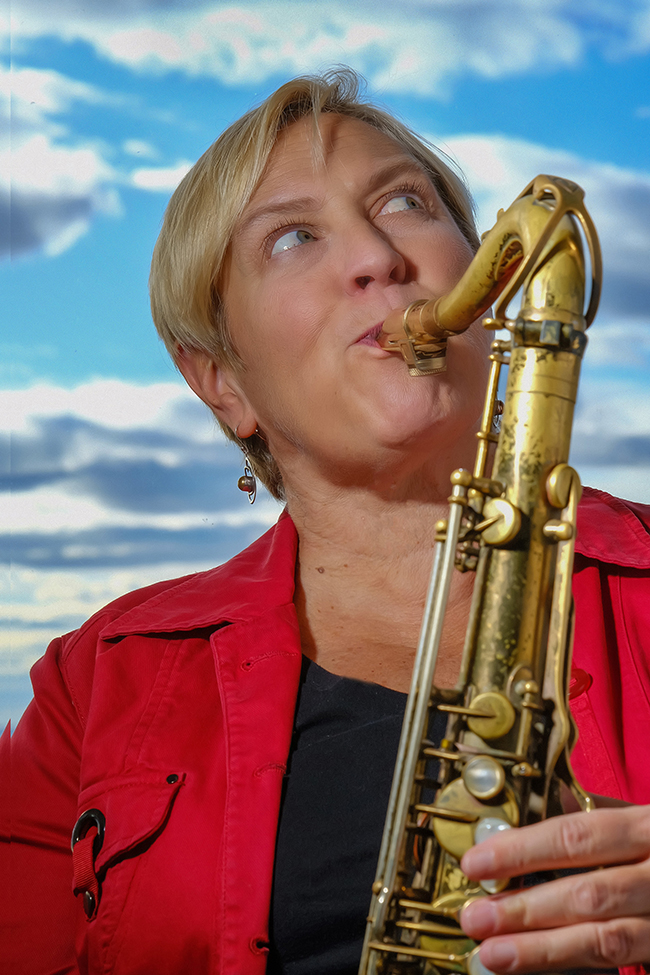
Large images, click to download:
Spotify
Pandora
Apple Music
Youtube
Saxophonist Lily White is one of the most promising and engaging musicians on the New York jazz scene. In small clubs or large concert halls, on alto, tenor, or soprano sax, Lily never fails to inject her sunny personality and sharp wit into her playing.
In the past, Lily has caught the attention of the music’s most reknowned veterans. She has worked with Mario Bauza, the father of latin jazz, and his Afro-Cuban jazz orchestra, touring with him in the final years before his death. She was a regular member of master organist Jimmy McGriff’s quartet from 1990-1994. She has done short stints with blues pianist Jay McShann, Dizzy Gillespie, and Celia Cruz to name a few. Recently, she has been working with Anthony Braxton and his tentet along with his Tri-centric orchestra, while still doing work with blues legend Roscoe Gordon on his new record.
Since the release of her first CD under her own name,“Somewhere Between Truth and Fiction”on Knitting Factory works, her band has played festivals and clubs in Germany, Sweden, Austria, Denmark, Lithuania, and Spain. In 1996, Lily was awarded with a Jazz Composition Grant from the National Endowment for the Arts. Also in 1996, her band was chosen by the Mid-Atlantic Arts Foundation for receiving matching funds from the Lila Wallace foundation for performances in not-for-profit locations around the U.S.A. In 1997, she has been awarded a “Meet the Composer” grant for an artist residency in a N.Y.C. school. Lily currently writes and performs with Audrarox which brings music to children and families, and is a member of the Douglass St. Composers Collective.
Lily has 2 more CDs on Jazz Focus Records: “No Pork Long Line” and the latest, “Big Blue Line.” This summer the quintet played stateside at the “Catskills Jazz, Rhythmand Blues Festival” on May 22nd.
Her new album, Daughter of Fortune with the Lily White Quintet was released November 11, 2023.
Review from David Gates
Saxophonist and composer Lily White has played Afro-Cuban jazz with Mario Bauza, soul jazz with Jimmy McGriff, avant-garde jazz with Anthony Braxton, and funky New Orleans jazz with the Swunky Z Brass Band. But Daughter of Fortune is jazz without qualifiers. All but two of the nine tunes are hers, and to play them she’s recreated the classic lineup of jazz’s great modernist period—trumpet, tenor, piano, bass and drums, the minimal yet versatile configuration that served both the straight-ahead Clifford Brown-Max Roach Quintet and the venturesome second quintet of Miles Davis, with Wayne Shorter, Herbie Hancock, Ron Carter and Tony Williams.
White’s reworking of Harold Land’s “Grooveyard”—Land played tenor with the Brown-Roach quintet—nods explicitly to the 1950s, and her own compositions, looser-limbed and more formally daring, show her admiration for Shorter’s writing for Miles. But her palette has many more colors: the Salvation Army-ish ensemble that begins and ends “Daughter of Fortune,” with its churchy piano chords; the old-school bebop unison line of the uptempo “Harlem Fling”; the Spanish-inflected “Yusef’s Dream,” the languorous Ellington-by-way-of-Mingus mood of the “Thelonious Mink.” (White’s also got a gift for titles.) Those vintage quintet recordings, wonderful as they were, could devolve into blowing sessions—soloists running the changes to show off their chops as a dismissively termed “rhythm section” chugged along. Daughter of Fortune is a collaborative, neo-Ellingtonian, enterprise, in which economical, well-considered solos shade out of and into the rich ensembles: listen to how Bennett Paster’s piano in “Side Effects,” after an intense and intricate conversation with its own inventions, continues in fleet, skipping high-register lines behind the horns. All the soloists distinguish themselves without hogging the spotlight: from Jim Whitney’s witty, insinuating bowed bass on “Grooveyard” to Dave Smith’s pure-toned trumpet on “Harlem Fling,” generating the excitement of a Miles or a Freddie Hubbard with no bleating or histrionics. On “Harlem,” Rob Garcia’s engrossing drum interlude (on those old records, you used to wish LPs could fast-forward) has a firm shape and trajectory. And White herself shines on every track. Her timbre can be warm or dry or growly as the moment demands, and she has an encyclopedic command of the saxophone’s resources: on the final track, “Yusef’s Dream,” she puts it all out there in about 45 remarkable seconds. In her every solo, you can hear her thinking, and feel her feeling. —David Gates
Daughter of Fortune points both back and forward: to where jazz used to be and to where it might go. Meanwhile, both the past and the future are in good hands.


